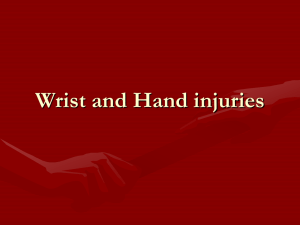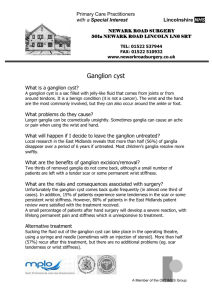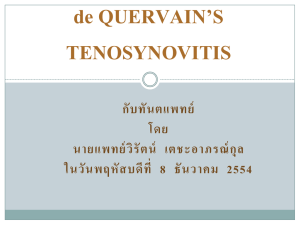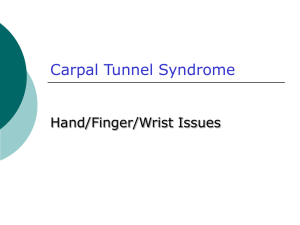Ganglions
advertisement
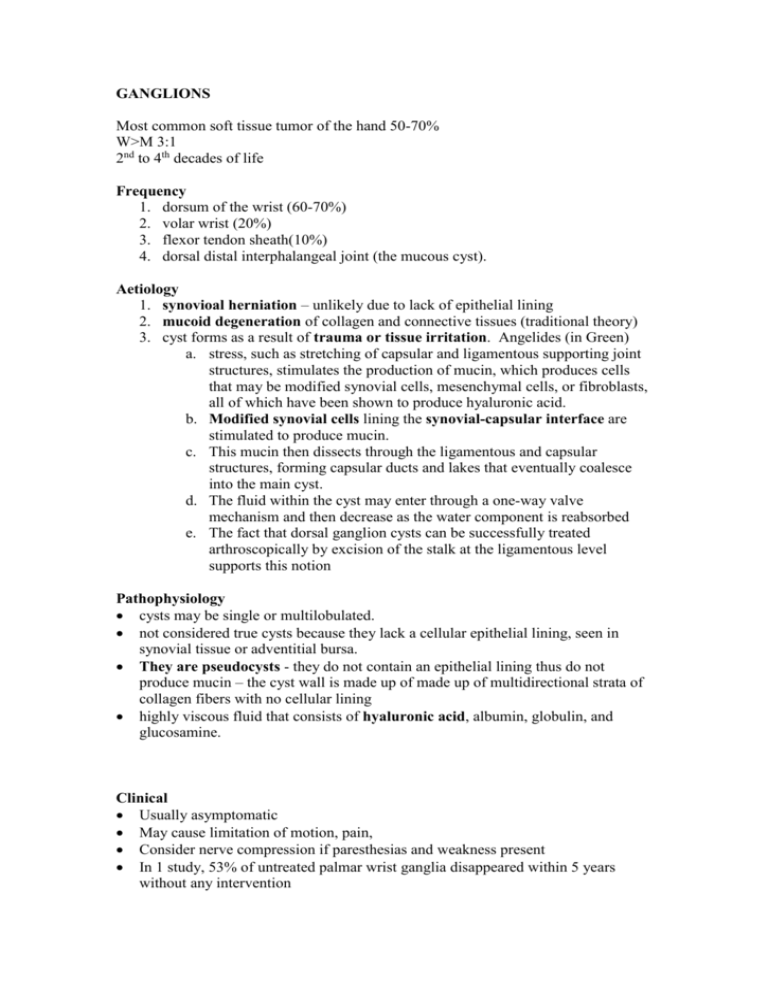
GANGLIONS Most common soft tissue tumor of the hand 50-70% W>M 3:1 2nd to 4th decades of life Frequency 1. dorsum of the wrist (60-70%) 2. volar wrist (20%) 3. flexor tendon sheath(10%) 4. dorsal distal interphalangeal joint (the mucous cyst). Aetiology 1. synovioal herniation – unlikely due to lack of epithelial lining 2. mucoid degeneration of collagen and connective tissues (traditional theory) 3. cyst forms as a result of trauma or tissue irritation. Angelides (in Green) a. stress, such as stretching of capsular and ligamentous supporting joint structures, stimulates the production of mucin, which produces cells that may be modified synovial cells, mesenchymal cells, or fibroblasts, all of which have been shown to produce hyaluronic acid. b. Modified synovial cells lining the synovial-capsular interface are stimulated to produce mucin. c. This mucin then dissects through the ligamentous and capsular structures, forming capsular ducts and lakes that eventually coalesce into the main cyst. d. The fluid within the cyst may enter through a one-way valve mechanism and then decrease as the water component is reabsorbed e. The fact that dorsal ganglion cysts can be successfully treated arthroscopically by excision of the stalk at the ligamentous level supports this notion Pathophysiology cysts may be single or multilobulated. not considered true cysts because they lack a cellular epithelial lining, seen in synovial tissue or adventitial bursa. They are pseudocysts - they do not contain an epithelial lining thus do not produce mucin – the cyst wall is made up of made up of multidirectional strata of collagen fibers with no cellular lining highly viscous fluid that consists of hyaluronic acid, albumin, globulin, and glucosamine. Clinical Usually asymptomatic May cause limitation of motion, pain, Consider nerve compression if paresthesias and weakness present In 1 study, 53% of untreated palmar wrist ganglia disappeared within 5 years without any intervention Investigations 1. High resolution US 2. MRI useful in localising origin Nonsurgical management 1. aspiration alone or followed by steroid injection. o This is especially successful for tendon sheath ganglions in the hand and digits. o splinting for 3 weeks improves the cure rate (40% for the splinted group versus 13% for the unsplinted group) o aspiration of volar wrist ganglions should be performed under imaging o Avoid injecting volar wrist ganglions due to proximity of radial artery o Steroid injections associated with skin and fat atrophy and thinning, as well as hypopigmentation. o Steroid injections not shown to reduce recurrence risk o Injection with steroid and with hyaluronidase shown in 1 study to be effective o Multiple needle puncture of the cyst site following aspiration does not appear to improve results o Use of sclerosing agents after aspiration can result in injury to the articular cartilage and is not recommended o 30-60% recurrence risk Surgical management 1. Surgical excision o Important to excise the stalk to reduce the risk of recurrence o wrist is immobilized in a plaster splint for 1 week, and then the splint and sutures are removed, and wrist motion is initiated. Recurrence of the cyst following surgery has been reported to range from 4% to 40% [26]. 2. Arthroscopic o Described principally for treatment of dorsal wrist ganglions o Ho (Arthroscopy 2003) has reported successful arthroscopic treatment of volar wrist ganglion o Dorsal wrist - arthroscope placed in the 6R portal (radial side of ECU), and a full radius resector introduced through the 3–4 portal (between EPL and EDC). o Volar wrist - arthroscope was inserted through a 3-4 portal and the shaver was inserted through a 1-2 radiocarpal portal (between ERCB and ERCL and proximal to crossing of EPL). Ganglions by Location Dorsal Wrist Ganglion Associated with scapholunate ligament May occur secondary to SL dissociation (dorsal wrist syndrome) o Conservative measures first o Consider excision of ganglion and PIN neurectomy Differential diagnosis for dorsal wrist ganglion cysts includes giant cell tumor of tendon sheath, lipoma, a true synovial cyst that may occur as a result of underlying wrist arthritis, tenosynovitis of the extensor tendons, or anomalous muscles such as extensor digitorum brevis manus May rarely cause impingement against the dorsal radial lip (pain) Typically occurs between EPL and EDC. Transverse wrist incision Radiocarpal capsule raised around ganglion Attachments of ganglion to Scapholunate ligament are divided Not necessary to cut into SLIL or curette the joint Complications 1. Early recurrences (5-15%) due to incomplete excision 2. stiffness – early volar flexion 3. hypertrophic scars – more likely with longitudinal incisions 4. Scapholunate dissociation – aggressive resection of SLIL Occult Wrist Ganglions Ganglion cysts of only a few millimeters in size may be the cause of chronic wrist pain Patients who present with pain arising from an occult dorsal wrist ganglion cyst usually complain of a vague aching discomfort in the wrist, which may be exacerbated by use. Patients may report discomfort that radiates proximally up the arm as well as weakness of grip. The discomfort associated with occult wrist ganglions is believed to occur as a result of localized irritation of branches of the posterior interosseous nerve. Palpable tenderness in the region of the dorsal scapholunate ligament should raise the suspicion for an occult dorsal wrist ganglion cyst as a possible source of the patient's symptoms. If sufficient suspicion exists, further diagnostic testing using ultrasonography or MRI can be helpful in identifying an occult ganglion cyst. Surgical excision of the cyst is often curative Volar wrist ganglion Most occur over distal edge of radius (radiocarpal joint between FCR and APL) or more distally over scaphoid tubercle (scaphotrapezial joint in 1/3rd) May also arise from FCR sheath (often in a slightly more medial location, either just radial or palmar to the sheath.) or from the first extensor compartment. These adhere to the sheath (extensor retinaculum), tend to be quite firm, are less mobile, and are often associated with de Quervain's extensor tenosynovitis. Differential diagnosis for volar wrist ganglion cysts includes giant cell tumor of tendon sheath, lipoma, a true synovial cyst that may occur as a result of underlying wrist arthritis, tenosynovitis of the flexor tendons and pseudoaneurysm of the radial artery Radiocarpal ganglions often entwined with radial artery – important to perform Allen’s test May be very extensive – under thenar, along FCR, into carpal tunnel causing median nerve compression Ganglions arising from the ulnar aspect of the wrist may extend into Guyon's canal, resulting in ulnar nerve compression Ganglion cysts may also arise from the ulnocarpal joint and are often associated with tears of the triangular fibrocartilage complex. Aspiration of anterior wrist ganglia should be undertaken with care because the radial artery often adheres to the cyst and may be at risk for injury. Recurrence following aspiration of anterior wrist ganglions is reported to be quite high Curved incision towards the carpal tunnel Preserve radial artery and palmar cutaneous branch, as well as branches from the lateral cutaneous nerve of the forearm, Complications include damage to radial artery, median nerve, PCN branch, hypersensitive scar, hypertrophic scar Volar retinacular ganglion (flexor tendon sheath) Usually arises from A1 pulley Does not move with tendon Neuropathic symptoms may arise if the volar retinacular cyst compresses or irritates the digital nerve. differential diagnosis includes giant cell tumor of tendon sheath, epidermoid inclusion cyst, foreign body granuloma, fibroma, lipoma, and neurilemmoma. Needle aspiration with steroids is worth attempting - the cyst is carefully injected with 1% lidocaine and a small amount of Methylprednisolone. The suspected cyst is palpated with the right index finger while the opposite hand is used to carefully place the needle into the cyst. Gentle pressure is applied to the syringe, and a sensation of distension is appreciated, which confirms the cystic nature of the lesion; then more local anesthetic and steroid is injected, often causing the cyst to rupture. Once the cyst has ruptured, the needle is advanced into the flexor sheath, and the remaining local anesthetic and steroid is injected into the flexor sheath. Mucous cyst Ganglion of DIPJ- most common IF and MF 5th to 7th decades Earliest sign is longitudinal grooving of nail caused by pressure Heberden’s nodes usually present Need to treat both cyst and osteophyte Access between terminal slip and collaterals. Surgical complications following mucous cyst excision include extensor lag, joint stiffness, and infection, including DIP joint pyarthrosis, nail plate deformity, and radial or ulnar deviation of the DIP joint Carpometacarpal boss Osteoarthritic spur at base of 2nd and 3rd CMCJ Most common in women, right hand and 3rd to 4th decades Often associated with small ganglions Need excision of ganglion and osteophytes cysts typically arise in the interval between the central extensor tendon and collateral ligament Transverse incision and access by pulling EDC and EI ulnarward. Intraosseous ganglions may be a cause of chronic wrist pain – more common with those in juxtaarticular location. Patients will present with the complaint of an aching wrist discomfort without antecedent trauma. Radiographic images may be negative or may reveal an intracarpal, sclerotic, well marginated lesion In patients who remain symptomatic and other potential causes of chronic wrist pain have been ruled out, curettage and bone grafting of the intraosseous cyst can be successful in alleviating the patient's symptoms. Other locations 1. PIPJ dorsally on either side of extensor tendon 2. on or within extensor tendons usually over the metacarpals (moves with extension) 3. First extensor compartment – in association with de Quervains 4. in Guyon’s canal – arising from hamate joints
